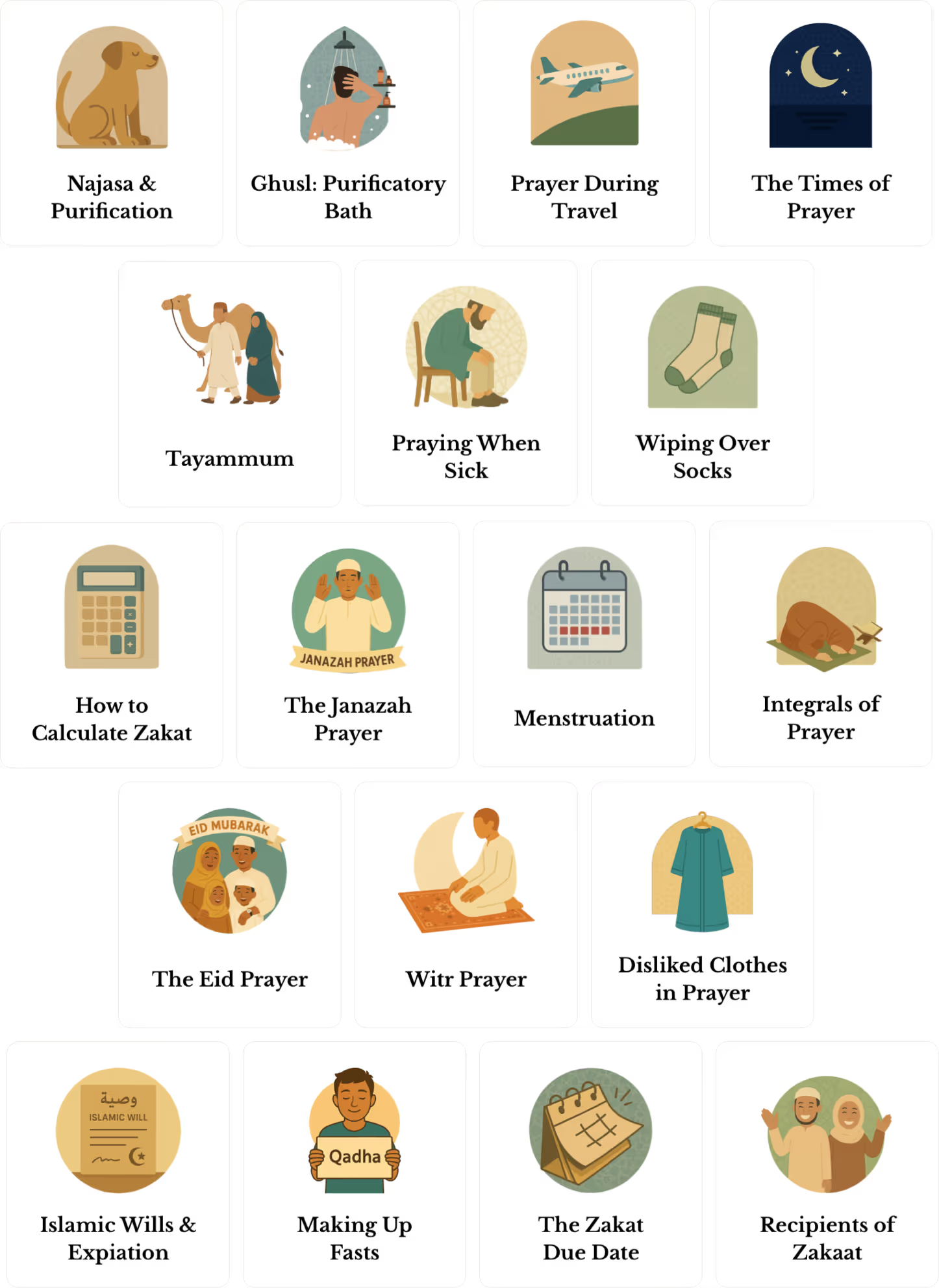How to Pray Witr Prayer in Hanafi Madhab
Witr prayer is an important part of a Muslim’s nightly worship. In Arabic, witr literally means “odd number,” reflecting that this prayer consists of an odd number of units (rakats).
It is performed after the obligatory Isha (night) prayer and is meant to be the final prayer of the night.
In the Hanafi school of thought, Witr is considered a wajib (necessary) prayer. This means Hanafis treat Witr very seriously, almost like an obligation, and one should make it up if missed.
The Prophet ﷺ emphasized its importance, saying,
"Allah has increased a prayer for you which is better for you than red camels. (It is) Witr, which Allah has enjoined on you between the ‘Isha’ prayer and the onset of dawn."
Sunan Ibn Majah 1168
In this comprehensive guide, we explain how to pray Witr according to the Hanafi madhab. We will cover the structure of the Witr salah, highlight how it differs from the three-rak‘ah Maghrib prayer, and discuss the special supplication (Du‘ā’ al-Qunūt) unique to Witr. Finally, you'll find a step-by-step walkthrough to perform Witr correctly.
Let’s begin with understanding what Witr is and why it’s unique in Hanafi practice.
What is the Witr Prayer and When Do You Pray It?
Witr is the last prayer of the night.
Its timing begins right after Isha prayer and extends until the break of dawn. It is highly recommended to delay Witr to the end of your nightly prayers - for example, after any tahajjud (night prayer) - so that it truly is your final prayer (this includes fard or sunnah prayers) before Fajr.
The Messenger of Allah ﷺ instructed:
"Make Witr as your last prayer at night."
Sahih al-Bukhari 998
If you fear you might not wakeup for late night prayer (tahajjud), it’s permissible and wise to pray Witr immediately after Isha before sleeping. But if you are confident you will wake up for extra prayers (tahajjud) in the last third of the night, you can delay Witr until after completing those.
In terms of its legal status, as noted, Hanafis classify Witr as wajib (necessary).
Practically, this means that a Hanafi should not deliberately omit Witr; if it is missed, it should be made up (qada) later.
How Many Rakats Is Witr in Hanafi Fiqh?
In the Hanafi method, Witr is three rakats performed consecutively as one prayer, similar to how Maghrib (the sunset prayer) is three rak‘ahs. You will pray all three units and then end with one taslim (saying salām to the right and left) at the end of the third rak‘ah.
It’s important to note that while Witr’s structure resembles Maghrib, there are some key differences in recitation within the prayer, as well as an extra supplication.
Ascent to Felicity by Imam Shurunbulali clearly mentions:
“The Witr prayer is just like Maghrib, except that it is mandatory to recite the Fātiha and an additional sūrah in the third rak‘a as well. After that, one says ‘Allāhu Akbar’ while raising the hands…”.
We will unpack this fully below.
In short, the first two rak‘ats of Witr are prayed identically to a normal prayer, but the third rak‘ah has additional requirements (a Qur’an recitation after fatiha, not usually done, and a special du‘ā’).
Key Differences Between Witr vs Maghrib
Since both Witr and Maghrib are three rakats, it helps to clarify the main differences between Witr and other prayers (e.g. Maghrib prayer) in the Hanafi school:
- Classification: Maghrib is an obligatory (fard) prayer, whereas Witr is deemed wājib (necessary) in the Hanafi madhab. This means intentionally skipping Witr is sinful in Hanafi fiqh, and one should make it up if missed.
- Extra Quranic Recitation in the Third Rak‘ah: In a fard prayer like Maghrib, it is sufficient (and common) to recite Sūrat al-Fātiha in the third rak‘ah without an additional sūrah. However, in Witr it is mandatory to recite Al-Fātiha and another sūrah or at least three verses in the third rak‘ah.
- Du‘ā’ al-Qunūt: The Witr prayer contains a special supplication called du‘ā’ al-qunūt (“prayer of supplication”) in the final rak‘ah, which Maghrib does not have. We perform this du‘ā’ right before going into the final ruku‘. This is explained in detail in the next section. Essentially, after reciting the Qur’ān in the third rak‘ah, you say an extra takbīr and read the qunūt supplication while standing, then proceed to bowing (ruku‘). Maghrib has no such addition.
- Silent vs. Audible: Maghrib prayer is prayed aloud (for the imam or a person praying alone, the first two rak‘ahs are recited loudly). Witr can be prayed either silently or softly aloud when alone; in Hanafi practice, it is often done quietly on a normal basis. However, if Witr is prayed in congregation (such as during Ramadan after Tarāwīh), the imam may recite the Qur’ān aloud in Witr. The Qunūt du‘ā’ in Hanafi practice is generally recited softly to oneself (not in unison or loud congregational chant).
- Congregation: Outside of Ramadan, Hanafis usually pray Witr individually. During Ramadan, however, it is permissible to pray Witr in jama’ah (congregation) after the Tarawih prayers. This is why in many mosques following the Hanafi madhab, the Imam leads a three-rak‘ah Witr congregation in Ramadan.
With these differences in mind, let’s look more closely at the special recitations involved in Witr, including what you should recite in each rak‘ah, and the content of the Qunūt du‘ā’.
Dua Qunoot: The Special Witr Supplication
Perhaps the most distinguishing element of Witr (in the Hanafi method) is the Dua al-Qunoot in the third rak‘ah. Qunoot (Qunūt) literally means “supplication” or “prayer.”
In practice, Dua Qunoot is a special dua that we read while standing in the prayer, after completing the Qur’an recitation in the final rakat of Witr and before going into ruku‘.
Order of Actions in Final Rakat of Witr:
Al-Fatiha -> Extra Quranic Recitation (not usually done in third rakat) -> Takbir -> Dua Qunoot -> Takbeer -> Ruku' -> continue as normal
Hanafi jurists state that reciting this dua’ is wājib (necessary) in Witr. This means one should not deliberately omit it; if forgotten, one would remedy the omission with the sajdat al-sahw (prostrations of forgetfulness) at the end of the prayer.
The Prophet ﷺ taught a specific Qunoot supplication for Witr, which is commonly memorized in Arabic. This Qunūt should be recited silently (in a low voice) by both the imam and follower when praying in congregation, as well as by an individual praying alone.
How to perform the Qunūt: After you finish reciting your surah in the third rak‘ah, say “Allāhu Akbar”. Many scholars note that you raise your hands for this extra takbīr (just as you would raise them when saying the opening takbīr of prayer), then fold your hands again. Now make the du‘ā’ from memory if you can. The well-known du‘ā’ al-qunūt for Witr is:
”اللَّهُمَّ إِنَّا نَسْتَعِينُكَ، وَنَسْتَغْفِرُكَ، وَنُؤْمِنُ بِكَ، وَنَتَوَكَّلُ عَلَيْكَ، وَنُثْنِي عَلَيْكَ وَلَا نَكْفُرُكَ، وَنَخْلَعُ وَنَتْرُكُ مَنْ يَكْفُرُكَ، اللَّهُمَّ إِيَّاكَ نَعْبُدُ، وَلَكَ نُصَلِّي وَنَسْجُدُ، وَإِلَيْكَ نَسْعَى وَنَحْفِدُ، نَرْجُو رَحْمَتَكَ، وَنَخْشَى عَذَابَكَ، إِنَّ عَذَابَكَ بِالْكُفَّارِ مُلْحَقٌ.“
“O Allah, we seek Your help, we seek Your forgiveness, we believe in You, we rely on You, we praise You, and we do not deny You. We forsake and leave anyone who disobeys You. O Allah, You alone we worship, to You we pray and prostrate, and to You we strive and hasten. We hope for Your mercy, and we fear Your punishment. Indeed, Your punishment will overtake the disbelievers.”
If you have not memorized the Qunūt du‘ā’ yet don’t worry. You are still required to make some supplication in that spot, but it can be any short du‘ā’ from the Qur’an or sunnah.
For example, you could simply say: اللهمَّ اغفر لي “Allāhumma-ghfir lī” (“O Allah, forgive me”), three times. This will suffice to fulfill the obligation of Qunūt if you don’t know the longer prayer. So do not let not knowing the full Qunūt keep you from performing Witr; use a short dua’ while you work on memorizing the longer one.
After completing the du‘ā’ in the third rak‘ah, you will say "Allāhu Akbar" and go into ruku‘ as usual to continue the prayer.
Having covered the unique aspects of Witr, let’s put it all together in a practical sequence. In the next section, we outline how to perform Witr step by step in the Hanafi way, emphasizing the additional elements that distinguish it from a regular Maghrib prayer.
How to Perform Witr Prayer (Hanafi): Step-by-Step Instructions
Performing Witr is straightforward once you are familiar with the differences from a normal prayer. Here is a step-by-step guide:
- Make the Intention (Niyyah): Stand facing the qibla (direction of prayer) and make an internal intention (in your heart) for Witr prayer.
- Begin the Prayer: Raise your hands to your earlobes (for men) or shoulders (for women) and say Allāhu Akbar to start the prayer. Fold your hands and recite the opening supplication and Sūrat al-Fātiha.
- First Rak‘ah – Recitation: After Al-Fātiha, recite a short surah or a portion of the Qur’an. Then continue the rak‘ah as normal: perform ruku‘ (bowing with Subḥāna Rabbiya-l-ʿAẓīm), rise with Samīʿallāhu liman ḥamidah, and perform the two sujūds (prostrations).
- Second Rak‘ah: Stand up for the second rak‘ah and again recite Al-Fātiha, then another surah or verses. Complete the second rak‘ah with ruku‘ and sujūd as you normally would.
- After the sujūd of this second rak‘ah, sit for tashahhud (the sitting intermission). This is the same as you do in Maghrib: sit and recite al-taḥiyyāt (“at-taḥiyyātu li-llāh…”) up to the Shahādah. Since this is not the final rak‘ah of the prayer, you will stop after the words “ashhadu alla ilāha illallāh wa ashhadu anna Muḥammadan ʿabduhu wa rasūluh”, i.e. complete the basic tashahhud. (You do not send salawat yet, nor end the prayer here because one more rak‘ah remains.)
- Rise to Third Rak‘ah: After the tashahhud, do not end the prayer. Instead, make takbīr (Allāhu Akbar) and stand up for the third rak‘ah. This is where Witr differs from Maghrib – in Maghrib you also stand for a third rak‘ah, but in Witr the following steps are unique. In this third rak‘ah, first recite Sūrat al-Fātiha as usual, and then must recite another surah or at least three verses of Qur’an (this is obligatory in Witr).
- Perform the Qunūt Supplication: After completing the Qur’an recitation in the third rak‘ah, do not go into ruku‘ yet. Now say “Allāhu Akbar” once more to initiate the Qunūt. Raise your hands up to your ears as you say this takbīr, then fold them again right after, just as you do at the start of prayer. You will now remain standing and quietly recite the Du‘ā’ al-Qunūt.
- Complete the Prayer: Upon finishing dua al-Qunoot, continue the prayer. Say Allāhu Akbar and go into the ruku‘ (bowing). From this point, you will perform the rest of the rak‘ah as normal: do the ruku‘ (with Subḥāna Rabbiya-l-ʿAẓīm), stand up saying “Samīʿallāhu liman ḥamidah, Rabbanā laka-l-ḥamd”, then make the two sujoods with Subḥāna Rabbiya-l-Aʿlā. Finally, sit for the last tashahhud after this third rak‘ah. In this final sitting, recite the full at-taḥiyyāt, the Allāhumma ṣalli ʿalā Muhammad (ṣalawāt upon the Prophet), and any closing du‘ā’ you wish to add (such as “Rabbi jʿalnī muqīmaṣ-ṣalāh…” etc., which is mustahabb).
- Taslim (Closing): End the Witr prayer by turning your head to the right and saying “As-salāmu ʿalaykum wa raḥmatullāh”, and then to the left with the same salām. With that, you have completed your three-rak‘ah Witr prayer.
If you followed these steps, you have performed Witr correctly according to the Hanafi madhab. Remember that all the integrals of salah (like maintaining purity, facing qibla, proper ruku‘ and sujood, etc.) apply to Witr just as they do to any other prayer.
What we outlined above highlights the additional elements specific to Witr, especially in the third rak‘ah.
Tips and Additional Points
- Qunoot throughout the Year: In the Hanafi school, the Dua al-Qunoot (Du‘ā’ al-Qunūt) is read in Witr all year round, not just in Ramadan. Every single night’s Witr includes this supplication.
- If You Forget Qunūt: If you accidentally omit the Qunūt or its extra takbīr and have already gone into ruku‘, do not try to recite it in ruku‘ or return to standing. Simply continue the prayer. Because leaving out the Qunūt in Witr means a wajib was missed, you should perform the two sujūd of forgetfulness (sajda sahw) before the salām to compensate.
- Praying in Congregation: As mentioned, outside of Ramadan it’s recommended to pray Witr on your own. However, if you are praying in jama‘ah (congregation) for Witr (e.g. in Ramadan), the follower should also quietly recite the Qunoot dua’ along with the imām. If the imām goes into ruku‘ before you’ve finished the du‘ā’, follow him to avoid missing the bowing, the imām’s timing takes precedence, and in such a case your Qunūt is considered fulfilled by whatever you managed to recite.
- Make Up If Missed: Since Witr is wajib for Hanafis, you should make up a missed Witr prayer later if you missed it during its time.
In summary, Witr in the Hanafi madhab is a three-rak‘ah prayer, similar in format to Maghrib but distinguished by an extra Qur’anic recitation in the third unit and the special Du‘ā’ al-Qunūt before bowing. It is performed as the last prayer of the night, and carries great reward and significance.
We ask Allah to accept your prayers. As you stand in the quiet of the night, remember that Witr is a gift – “an additional prayer better than a red camel” as the Prophet ﷺ described – so value it and perform it with sincerity and devotion.
FAQs
How do you pray Witr prayer?
In the Hanafi madhab, Witr prayer is performed as three rakats after Isha. After the second rakat, you stand up for the third, recite Surah Al-Fatiha and another surah (unique to Witr prayer), then recite Dua Qunoot before completing the prayer.
How to pray 3 rakats of Witr?
To pray three rakats of Witr in Hanafi fiqh, pray two rakats as usual, then stand for the third rakat. In the third rakat, after reciting Surah Al-Fatiha and another surah, recite Dua Qunoot before going into ruku and completing the prayer.
What is meant by Witr prayer?
Witr prayer is an odd-numbered prayer performed after Isha and is considered wajib (necessary) in the Hanafi school. It is the final prayer of the night and includes a special supplication called Dua Qunoot.
Is it permissible to pray only 1 rakat Witr?
No, in the Hanafi madhab, Witr must be prayed as three rakats and not as a single rakat.
How to perform 3 rakat of Witr?
Perform two rakats as you would in other prayers, then stand for the third rakat. In the third rakat, after reciting Surah Al-Fatiha and another surah, recite Dua Qunoot before proceeding to ruku and completing the prayer.
How do Hanafis pray Witr?
Hanafis pray Witr as three rakats after Isha, with Dua Qunoot recited in the third rakat before ruku. This structure is unique and differs from other schools.
When to pray Witr salah?
Witr salah is prayed after all your other night prayers (fard and sunnahs) such as Isha prayer & Tahajjud and before the onset of dawn (Fajr). It is meant to be the very last prayer of the night (next time you pray will be Fajr).
Is Witr prayer the same as Maghrib?
No, Witr prayer is not the same as Maghrib. While both have three rakats, Witr includes Dua Qunoot in the third rakat and differs in structure and intention.
Is it prohibited to pray Witr like Maghrib?
Yes, it is prohibited to pray Witr exactly like Maghrib. The Prophet ﷺ instructed that Witr should not be performed in the same manner as Maghrib, and the inclusion of Dua Qunoot in the third rakat distinguishes it and is wajib.
Did the Prophet forbid to pray Witr like Maghrib?
Yes, the Prophet ﷺ forbade praying Witr in the same way as Maghrib, emphasizing that Witr should have a unique structure, particularly with the recitation of Dua Qunoot in the third rakat.

















.avif)

Lorem ipsum dolor sit amet, consectetur adipiscing elit. Suspendisse varius enim in eros elementum tristique. Duis cursus, mi quis viverra ornare, eros dolor interdum nulla, ut commodo diam libero vitae erat. Aenean faucibus nibh et justo cursus id rutrum lorem imperdiet. Nunc ut sem vitae risus tristique posuere.
Lorem ipsum dolor sit amet, consectetur adipiscing elit. Suspendisse varius enim in eros elementum tristique. Duis cursus, mi quis viverra ornare, eros dolor interdum nulla, ut commodo diam libero vitae erat. Aenean faucibus nibh et justo cursus id rutrum lorem imperdiet. Nunc ut sem vitae risus tristique posuere.